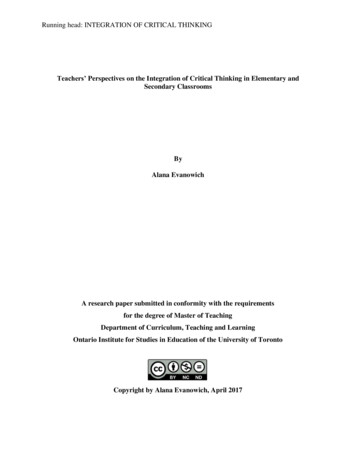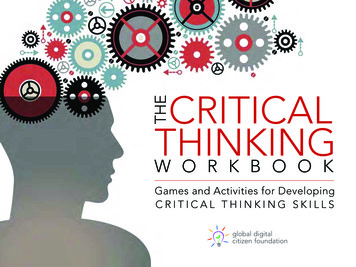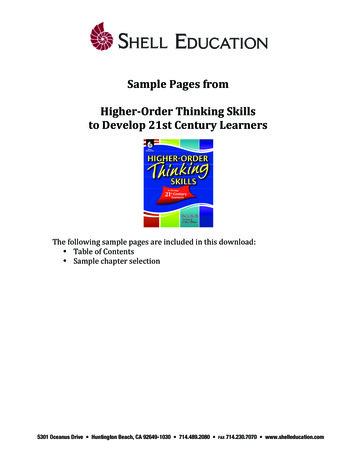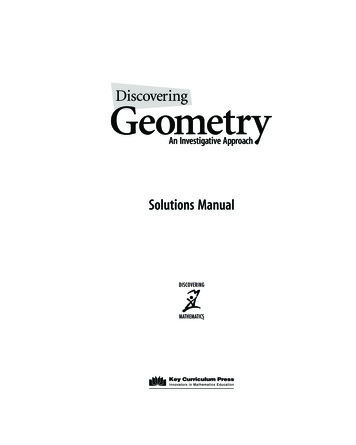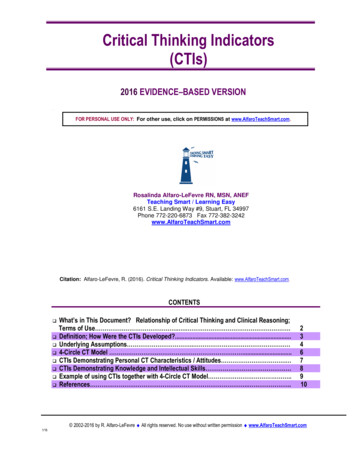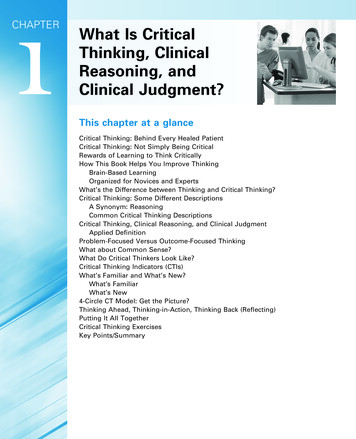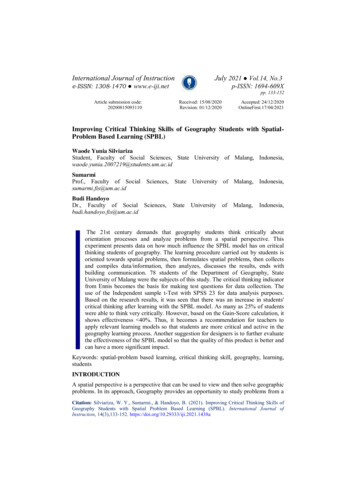
Transcription
International Journal of InstructionJuly 2021 Vol.14, No.3e-ISSN: 1308-1470 www.e-iji.netArticle submission code:20200815093110p-ISSN: 1694-609Xpp. 133-152Received: 15/08/2020Revision: 01/12/2020Accepted: 24/12/2020OnlineFirst:17/04/2021Improving Critical Thinking Skills of Geography Students with SpatialProblem Based Learning (SPBL)Waode Yunia SilviarizaStudent, Faculty of Social Sciences, State University of Malang, armiProf., Faculty of Social Sciences, State University of Malang, Indonesia,sumarmi.fis@um.ac.idBudi HandoyoDr., Faculty of Social fMalang,Indonesia,The 21st century demands that geography students think critically aboutorientation processes and analyze problems from a spatial perspective. Thisexperiment presents data on how much influence the SPBL model has on criticalthinking students of geography. The learning procedure carried out by students isoriented towards spatial problems, then formulates spatial problems, then collectsand compiles data/information, then analyzes, discusses the results, ends withbuilding communication. 78 students of the Department of Geography, StateUniversity of Malang were the subjects of this study. The critical thinking indicatorfrom Ennis becomes the basis for making test questions for data collection. Theuse of the Independent sample t-Test with SPSS 23 for data analysis purposes.Based on the research results, it was seen that there was an increase in students'critical thinking after learning with the SPBL model. As many as 25% of studentswere able to think very critically. However, based on the Gain-Score calculation, itshows effectiveness 40%. Thus, it becomes a recommendation for teachers toapply relevant learning models so that students are more critical and active in thegeography learning process. Another suggestion for designers is to further evaluatethe effectiveness of the SPBL model so that the quality of this product is better andcan have a more significant impact.Keywords: spatial-problem based learning, critical thinking skill, geography, learning,studentsINTRODUCTIONA spatial perspective is a perspective that can be used to view and then solve geographicproblems. In its approach, Geography provides an opportunity to study problems from aCitation: Silviariza, W. Y., Sumarmi., & Handoyo, B. (2021). Improving Critical Thinking Skills ofGeography Students with Spatial Problem Based Learning (SPBL). International Journal ofInstruction, 14(3),133-152. https://doi.org/10.29333/iji.2021.1438a
134Improving Critical Thinking Skills of Geography Students spatial perspective (Yunus, 2008). Therefore, learning by recognizing and solving itwith a spatial approach and analysis studying the problem, and looking at the problemfrom a spatial perspective is characteristic of true geography learning (Chun, 2010;Bednarz & Bednarz, 2008).Geography learning in the 21st century must direct students to look at problems andsolve them from a geographical perspective, one of which is spatial (Nagel, 2008).Therefore, learning guidelines are important to support students to be active and criticalin seeing and solving problems as well as being communicative by the 21st CenturyGeography education objectives.Human resources in the 21st century are important to have critical thinking skills(Snyder & Snyder, 2008; Alismail, & McGuire, 2015; Sumarmi, 2017; AlJaafi & Şahin,2019; Affandy, et al., 2019). Thus, the target of teachers in this century is important toprepare graduates who can think critically. Students who can think critically can facechallenges in the future (Tsui, 2002; Ennis, 2011). Life and career readiness requirecritical thinking skills (Kraisuth & Panjakajornsak, 2017). Even employers look forindividuals who are not only capable of reading and writing but also capable of criticalthinking (Casner-Lotto, & Barrington, 2006; Sulaiman et al., 2008).The 2010 survey notes reported that the 21st-century business world needs humanresources with critical thinking skills (AMA, 2010). Other contemporary evidenceshows that critical thinking is of utmost importance, according to 144 entrepreneurssurveyed (NACE, 2016). One of the ASEAN countries, in Thailand Vision 4.0,establishes critical thinking as a key pillar in the development of a new knowledgebased economy (Jones & Pimdee, 2017).Every individual needs to have critical thinking skills. Student learning conditions areoften with a learning approach that is limited to discussing the material in books andtends to be not factual (Elbow & Sharma, 2000). This is another challenge for teachersto encourage students to think critically (Karakoç, 2016). Therefore, an educator mustthink a lot in facilitating a class by choosing the latest models and methods that are moreeffective in directing and facilitating students to think critically.Making the right decision is an indication that students think critically. Critical thinkingmust involve students in researching, differentiating, and evaluating information andreflection related to data and information to make judgments and convey decisions(Papathanasiou et al., 2014; Snyder & Snyder, 2008). The critical thinking processtrains students to make decisions with scientific steps.Most students in Indonesia lack 21st-century skills. Several reports prove thatIndonesian students are still classified as low in critical thinking (Wayudi, et al., 2019;Susilowati, et al., 2017; Suardana & Selamet, 2017). Therefore, teachers and studentsneed learning guidelines that facilitate the learning atmosphere to be critical.The learning model is a guideline and framework that can support learning (Sumarmi,2012). SPBL is one of them. The uniqueness of SPBL is that it provides opportunitiesInternational Journal of Instruction, July 2021 Vol.14, No.3
Silviariza, Sumarmi & Handoyo135for geography students to study a problem actively and scientifically and solve it with aspatial approach (Silviariza & Handoyo, 2020).SPBL with problem-solving characteristics with a spatial approach has the advantage tobe applied to develop 21st-century skills. These advantages are: (1) students work inteams (Sun, et al., 2018), (2) With scientific observations and activities allow students toidentify and formulate spatial problems (Darmaji, et al., 2019), (3) students thinkcritically about contextual and factual spatial problems that want to achieve meaningfullearning (Koohang et al., Nd; Loveless et al., 2006; Swan, 2005; Utami et al., 2016), (4)students can describe the relationship between one phenomenon with another(Nursa'ban, et al, 2020), (5) with scientific activities that allow students to practicemaking decisions from these spatial problems (Pérez - delHoyo, et al, 2020). With theapplication of SPBL, it is very appropriate to provide scientific Geography learning,hone teamwork skills, sensitivity, and critical decision making for students. Based onthese descriptions, the researcher formulated two hypotheses as follows: "a class thatapplies the SPBL model during the learning process gets a higher critical thinking scorethan a class that does not". The purpose of this study is to produce information that theSPBL model affects improving students' critical thinking in higher education.Literature ReviewSPBL as a Model of TeachingSPBL is created from integrating Problem Based Learning (PBL) with the same spatialgeographic perspective as Spatial Based Learning (SBL) (Silviariza & Handoyo, 2020).The integration between the SBL model which focuses on students' way of thinkingabout space and the PBL model which focuses on problem-solving makes SPBL aproblem-solving-based Geography learning model with a geographical perspective witha spatial approach (Silviariza & Handoyo, 2020). The implementation of the SPBLmodel aims to create an atmosphere of learning geography that is scientific, active,critical, creative, collaborative, and innovative in solving Geography problems(Silviariza, et al, 2020). Thus, the application of SPBL in geography classes canfamiliarize students with critical thinking to solve problems with a spatial approach.This is motivated because in learning geography it is very important to solve problemscritically (Nagel, 2008). Geography learning is a multidisciplinary science that containscomplex and authentic spatial problems that allow students to solve problems critically(Huang et al., 2012). Thus, the application of SPBL in Geography subjects can influencecritical thinking activities in solving geographic problems with a spatial approach.Furthermore, the table below describes the activities of each step in the SPBL model.International Journal of Instruction, July 2021 Vol.14, No.3
136Improving Critical Thinking Skills of Geography Students Table 1Step design for the SPBL learning modelNo1SyntaxOrienting Spatialproblem2Formulating spatialproblems3Collecting andorganizing spatialdata andinformationAnalyzing spatialdata and discussingthe results45BuildingcommunicationActivityStudents scrutinize directly the spatial phenomena in the field. The teacherbecomes a facilitator by providing opportunities for students to recognizespace with the initial step of knowing its absolute and relative locations,then looking at its spatial characteristics (cultural, social, and eveneconomic if needed), and recognizing the factors associated with that space.The orientation of the problem in space is also done with related spatialmaps. This makes it easier for teachers and students to recognize objectsspatially. Non-forcefully, this activity allows students to think from a spatialperspectiveThe activity of formulating spatial problems begins with student activitiesin identifying the relationship between space and spatial phenomenaFor data and information from data collection results to be neatly organizedand easy to read, students make tables, graphs, diagramsAfter organizing and processing the data, students analyzed and discussed itwith their respective groups. Students analyze spatially with various spatialanalysis techniques that are following the characteristics and objectives ofthe data. In analyzing the data that has been collected, students can use dataprocessing applications even if they need a Geographical InformationSystem (GIS), SPSS is also suggested.In addition to building good communication skills, at this stage students arewelcome to present their arguments by the data and group discussions withother groups.Source: (Silviariza & Handoyo, 2020)The SPBL model has five steps. The steps for the SPBL Geography learning model areas follows (Silviariza & Handoyo, 2020); (1) orientate spatial problems, (2) formulatespatial problems, (3) collect, organize spatial data and information, (4) analyze spatialdata, (5) build communication.The concept of Critical Thinking SkillThe demands of the 21st century are challenging humans as individuals and even groupsto think critically in seeing and solving problems (Lai, 2011; Higgins, 2014; Snyder &Snyder, 2008; Wagner, 2010; P21, 2015; Kereluik, 2013). Critical thinking is a skill thatgoes beyond memorization (Kraisuth & Panjakajornsak, 2017; Haridza & Irving, 2017).The world of work requires human resources who have skills other than basicknowledge (NACE, 2016; Sulaiman et al., 2008; Tapper, 2004) in problem-solving(Conklin, 2012).Sharing their opinions, listening to other people's opinions, summarizing concepts withanalysis, confirming and/or defending their opinions, making decisions, and solvingproblems in the real world are the characteristics of critical students (Nelson, 2013;ŽivkoviĿ, 2016; Karakoç, 2016). Students must behave intellectually and in aconstellation that allows the person to be accustomed to thinking critically (Kereluik,2013). One must improve critical thinking skills from school (Facione, 2011). StudentsInternational Journal of Instruction, July 2021 Vol.14, No.3
137Silviariza, Sumarmi & Handoyomust be accustomed to asking, interpreting, synthesizing, and digesting (Paul & Elder,2019).Critical thinking activities are a student thinking process starting with asking questions(Nappi, 2017), examination (Yanchar, & Slife, 2004), analysis (Saputra, et al, 2019),testing (Fatmawati, et al, 2019), and exploration (Rahmat, et al. al. al., 2020). Therefore,students need to recheck the scientific truth of each reason and gather facts from eachside to think critically. Students become critical if they meet the indicators of criticalthinking (Facione, 2000). Critical thinking indicators from Ennis (2011) become thebenchmark for this study. The following provides indicators of critical thinking relatedto the syntax of the SPBL model (table 2).Table 2Indicators of students' critical thinking skillsNoCritical Thinking Skills1Formulation of The Problem23456Giving ArgumentsDoing DeductionDoing InductionEvaluatingDeciding and ImplementingSource: (Ennis, 2011)IndicatorFormulation of problems and provide directions to obtainanswersProviding arguments accompanied by suggestionsProviding an explanation from general to specificMaking conclusions about the problemEvaluation based on factsDetermination and selection of alternative solutions toproblems for planning and implementationTrain students' critical thinking skills as well by using learning strategies. Constructingcategorization, finding problems, and improving the environment are importantstrategies to encourage students to think critically (Facione, 2000). This strategy has thesame goals as the SPBL syntax.Table 3The relevance of SPBL with strategies and indicators of criticalNO123SPBL stepsStrategySpatial problem orientationFormulating spatial problemsCollecting and organizingspatial data and informationBuilding CategoriesFinding ProblemEnhancing EnvironmentIndicator of Critical ThinkingGiving ArgumentsFormulating the ProblemGiving ArgumentsConducting Induction and DeductionConducting Induction and Deduction4Analyzing spatial data anddiscussing the resultsEnhancing Environment5Building CommunicationEnhancing EnvironmentGiving ArgumentsEvaluatingConducting Induction and DeductionGiving ArgumentsConducting Induction and DeductionEvaluatingDeciding and ImplementingSource: (Facione, 2000; Silviariza & Handoyo, 2020)International Journal of Instruction, July 2021 Vol.14, No.3
138Improving Critical Thinking Skills of Geography Students Thus, the application of SPBL is relevant with the aim of improving students' criticalthinking.METHODResearch DesignQuasi-experimental with a pre-posttest control group is the design of this study. Figure 1below is an illustration of how the experiment was carried out.ExperimentO1XO2ControlO3O4Figure 1The quasi-experimental procedure was adapted from Fraenkel et al. (2011)SubjectBased on practical reasons, conditions, and ethics in the quasi-experimental sampledesign is not selective (Campbell & Stanley, 2015; Fraenkel et al., 2011). The use of apurposive sampling technique to obtain samples that have the same characteristics ofcritical thinking skills. Another thing also shows that each class has the same ability; noclass is superior. besides, taught by the same lecturer in the same subjects. Thus, theselection of class “K” as an experiment and class “A” as a control.Experimental research was conducted in the 2018 Geography Education study program,State University of Malang (UM) in two different classes. Experimental researchsubjects were selected in the "Environmental Geography" class. The objectives of the"Environmental Geography" class; (1) examining the human environment; (2) criticalhuman; (3) creative humans in protecting the environment; (4) people who activelyprotect the environment. These objectives are appropriate when implementing the SPBLmodel.Instruments and ProceduresThe purpose of testing the validity and reliability is to ensure that the instrument is goodat measuring symptoms and produces valid data (Purwanto, 2009). 30 students who hadtaken the "environmental geography" course were top targets for the instrument test(validity and reliability). This means that the subject has learned how to recognizeenvironmental problems and solve these problems.At the beginning of the class meeting, students worked on the pretest questions. Thisaims to determine the initial abilities of students. Furthermore, the treatment uses theSPBL model. Furthermore, data collection from the final test to the experimental andcontrol groups. The next step, data collection posttest results of the two subject groups.The data shows the critical thinking skills of control and experimental students beforeand after treatment with the SPBL model. The pre and post-test score calculation use thefollowing equation (Purwanto, 2009).International Journal of Instruction, July 2021 Vol.14, No.3
139Silviariza, Sumarmi & HandoyoxDescription:n: final score B: total correct (a grade that can be achieved by students)smi: Highest score ideal (32)n max: the highest score used (100).Five questions related to environmental problems to measure whether students can thinkcritically or not. The test questions are arranged based on indicators of critical thinking(Ennis, 2011). To answer these questions, the teacher provides students with spatialcontextual questions from newspaper articles. Following are the item validationqualifications.Table 4Qualification of Item validationCorrelation coefficient0.800 – 1.0000.600 – 0.7990.400 – 0.5990.200 – 0.4000.000 – 0.199Source: (Purwanto, 2012)QualificationHighly ValidValidValid enoughLess validInvalidThe 5% significance level becomes the basis for the analysis of the validity test using atwo-sided test (α) .444. Furthermore, the critical thinking skills test was declared validbased on the social material classification criteria. The results of statistical calculationsfor each item with sig. (2-tailed) 0.444. In addition to validity, the measurement ofinstrument reliability is as follows.Table 5Item reliability criteriaReliability value0.00 – 0.200.21 – 0.400.41 – 0.600.61 – 0.800.81 – 1.00Source: (Arikunto, 2010)CriteriaVery lowLowAverageHighVery HighThe summary table presenting the results based on the reliability test is as follows.International Journal of Instruction, July 2021 Vol.14, No.3
140Improving Critical Thinking Skills of Geography Students Table 6Item reliability criteriaQuestion 70.798Reliability0.707From the table above, we can conclude that the instruments used to collect valid andreliable data on critical thinking skills.Data AnalysisProof of improving students' critical thinking by testing the hypothesis. Hypothesistesting with SPSS 23 for windows uses the Independent sample t-test.Table 7Criteria for critical thinking skillsClassificationABCDEScore81 – 10066 – 8056 – 6541 – 550 – 40QualificationHighly criticalCriticalCritical enoughLess criticalNot criticalTable 7 indicates a significance level of 0.05 applies to decision making with the t-test(Purwanto, 2012).FINDINGSPrerequisite TestingProof of sample data is normally distributed or not by normality testing. It is normallydistributed if most of it is close to average. SPSS with a 95% Kοmlοgοrοr Smirnοv Testhelps іn normality testing. Summary of test results according to the following table.Table 8Normality TetsCriticalThinkingClassPreTest ExperimentPostTest ExperimentPreTest ControlPostTest ControlKolmogorov-SmirnovaStatistic piro-WilkStatistic national Journal of Instruction, July 2021 Vol.14, No.3
141Silviariza, Sumarmi & Handoyoanalysis by Kοlmοgοf Smirnοv. The (2-tailed) experimental group showed that thepretest was 0.141 and the post-test was 0.200. The next is the control class with pre-testsis 0.095 and a post-test of 0.130.Furthermore, homogeneity test to show the diversity in the two subject groups. Thehomogeneity test uses Levene's test at the 95% significance level.Table 9Homogeneity of variance testCriticalThinkingMeanMedianMedian and with adjusted dfBased on trimmed meanLevene 6Sig.267.314.314.291The Levene test for the homogeneity test in the table below states the probability result(sig.) 0.05. So, H0 is rejected. In conclusion, the level of critical thinking of the twoclasses has homogeneous diversity.Hypothesis TestingThe hypothesis test aims to decide whether to accept or reject a hypothesis. Hypothesistesting has a significant level of 0.05 (Independent Sample t-Test). Hypothesis testingaims to provide knowledge about the effect of the SPBL model on improving the criticalthinking skills of Geography students. The conditions for making this hypotheticaldecision are as follows:H1 students who apply the SPBL model during the learning process get ahigher score of critical thinking skills than those who do not.H0 students who apply the SPBL model during the learning process did not geta higher score of critical thinking skills than those who do not.Table 10Group statisticClassCritical Experiement Post-testThinkingResults Control post-testN40Mean73.95Std.Deviation7.268Std.Error Mean1.1493863.219.4501.533From the results of data acquisition after treatment, both groups showed a significantmean value. This shows that the SPBL model provides an increase in students' criticalthinking skills.International Journal of Instruction, July 2021 Vol.14, No.3
142Improving Critical Thinking Skills of Geography Students Table 11Independent sample t-testLevene's Testfor Equality ofVariancesEqualvariancesThe result assumedof critical Equalthinking variancesnotassumedt-test for Equality of MeansSig. (2Meantailed) DifferenceStd.ErrorDifference95% ConfidenceInterval of theDifferenceLower 4.5305.60569.456.00010.7391.9166.91814.561The results of statistical analysis stated that the hypothesis testing was 0.000 for sig (2tailed). Thus, the probability value is 0.000 0.05 and the mean value of students'critical thinking after the post-test in the experimental class is (74) complete class (63).This means that H0 is rejected.Experimental and Control Class Critical Thinking SkillsTable 12 contains information about the acquisition of data from the pre and post-testscores in the experimental and control classes, then the preparation of the frequencydistribution of students' critical thinking with the table.Table 12The Frequency Distribution of The Pre and Post-Test Data for the Experimental andControl ClassesQualificationHighly criticalCriticalCritical enoughLess criticalNot criticalPre-test FrequenceExperimentalClass0141862Post-test frequenceExperimental Class1024600Pre-testFrequenceControl Class0121592Post-testfrequenceControl Class0141860The table contains information about increasing critical thinking in both subject groups.The experimental group showed an increase in the value of critical thinking compared tothe control group. The post-test results showed that most students in the experimentalgroup could think critically. Thus, critical thinking scores changed significantly in theexperiment class. the frequency distribution for the experimental class can be illustratedin the following graph.International Journal of Instruction, July 2021 Vol.14, No.3
Silviariza, Sumarmi & Handoyo143Figure 2Comparison of Pre-Test and Post-Test Results in Experiment group in GraphThe graph above provides information about increasing scores in the experimental groupafter treatment. The qualification critical score of the pre-test was 35%, while the posttest was 60%. Qualification score was quite critical at the pre-test by 45% and 15% atthe post-test. Highly critical score qualification at the post-test was higher by 25% and0% at the pre-test. In the pre-test, 15% and 0% in the post-test, there is a qualifyingscore that is less critical. Then, the percentage difference between the control groups isdepicted in the graph below.Figure 3Comparison of the results of the control class pre-test and post-test in a graphInternational Journal of Instruction, July 2021 Vol.14, No.3
144Improving Critical Thinking Skills of Geography Students The graphs describe that there is no "quite critical" score at the pre-test of 39% and 47%at the post-test. Qualification of the critical score at the post-test was higher at 37% and32% at the pre-test. Qualification was less critical at the pre-test by 24% and 16% at thepre-test. The not critical score is 5% on the initial test and the post-test is 0%.From the discussion of these data, it was concluded that the SPBL model improvedstudents' critical thinking skills. However, other findings can provide a new perspectivefor the SPBL model. The results of the calculation of the N-Gain Score, the SPBLmodel is not yet effective. This is evidenced from the results of the analysis using SPSSversion 23 for windows. A summary of the calculations can be seen in the table below.Table 13Summary of N-Gain Score CalculationNGain 0447.83Std. Error1.90395Percentage31.8 2.843195.5 %Based on the provisions of the experimental effectiveness of a product if it has apercentage value 76%, it is quite effective when it has a percentage of 56-75%, lesseffective if it is 40-55%, and is declared ineffective when it is 40% (Hake, R. R, 1999).The effectiveness of the SPBL model in the experimental class 40% is 31.8%. Thisfinding is evidence, although SPBL affects improving students' critical thinking, theSPBL model cannot be declared effective. Meanwhile, to improve students' criticalthinking, conventional methods such as lectures applied to control classes are no longerrecommended.DISCUSSIONPrevious research supports the argument that the application of the scientific learningmodel is superior to conventional learning with the lecture method (Aliman et al., 2019;Farah et al., 2018; Handoyo et al., 2016; Sari et al., 2019; Sumarmi et al., 2019;Sumarmi̇ et al., 2019; Sumarmi̇ et al., 2019; Sumarmi̇ et al. Al., 2020; Aliman et al.,2020; Umiyaroh, 2017). Interactive learning affects the improvement of students' criticalthinking (Utami et al., 2016). Acquisition of student knowledge directly from studentsearches and experiences (Puspitasari et al., 2016) from the scientific learning process(El Bedawy, 2017; Erikson & Erikson, 2019; Syaodih et al., 2019; Woa et al., 2018).The results of field observations show that the SPBL syntax is based on theirexperience, students work together to investigate scientifically to collect data, organizedata and analyze data with a spatial approach (Silviariza & Handoyo, 2020). Thescientific syntax can encourage critical thinking (Halim & Mohtar, 2015; Shaughnessyet al., 2017). Thus, the implementation of the SPBL model provides students with ascientific learning experience in solving critical problems spatially. The implementationInternational Journal of Instruction, July 2021 Vol.14, No.3
Silviariza, Sumarmi & Handoyo145of the SPBL model helps students solve problems based on a spatial perspective. As iswell known, problem-solving based on a spatial point of view is a characteristic ofGeography (Goodchild et al., 2007; Huynh, 2009; Miller, 2000; Shoorcheh, 2019).The research at the first meeting was carried out by pre-test, three meetings took placeas usual with the topic of learning "Human Resources with Environmental Insights" andone last meeting took place by carrying out a post-test. Each meeting has a time of 100minutes.The first meeting in the experimental class (pre-test) took place on November 14, 2019.The second meeting took place on November 21, 2019. The third meeting took place onNovember 28, 2019. The fourth meeting took place on December 5, 2019. The lastmeeting (pοst-test) was held on 12 December 2019.The process of learning is oriented towards environmental problems by looking at thespatial pattern (Marshall, et al, 2011). The spatial-based orientation of environmentalproblems is used with the activity sheet guide. The syntax of the PBL model is adjustedto the student activity sheets. Students are given a stimulus to ask questions and begin toidentify some problems. The critical thinking process emerges at this stage. (Paul, &Elder, 1990). This is based on a learning strategy by providing opportunities for studentsto think critically (Bonie & Potts in Amri, 2012).Class K as the experimental group with the SPBL model has a higher thinking abilitythan the control group which is a class A student. Thus, with the results of experimentalresearch in the form of statistical data calculations. In conclusion, there is an effect ofthe SPBL model treatment on the increase in critical thinking of Geography students.The control group with conventional treatment did not show a significant increase incritical thinking. In literature class, students are dominant as listeners by relying onsubject matter from the teacher so that they are less literate (passive). Teachers areconsidered the main source of information and knowledge in solving problems(Marmah, 2014). Students are reluctant to look for sources of information directly in thefield.When conducting group discussions in the control class, most students presentedarguments that were not based on data. This proves that students' critical thinking is notoptimal (Ennis, 2011). Also, some students were not enthusiastic about participating inthe discussion. Researchers assume that this is due to lessons that take place during theday after recess.Another thing with the experimental group treatment with SPBL, students were able toidentify problems from a spatial perspective, orient problems spatially, formulateproblems, collect and compile data and information spatially, analyze data andinformation spatially together and communicate scien
The 21st century demands that geography students think critically about orientation processes and analyze problems from a spatial perspective. This experiment presents data on how much influence the SPBL model has on critical thinking students of geography. The



